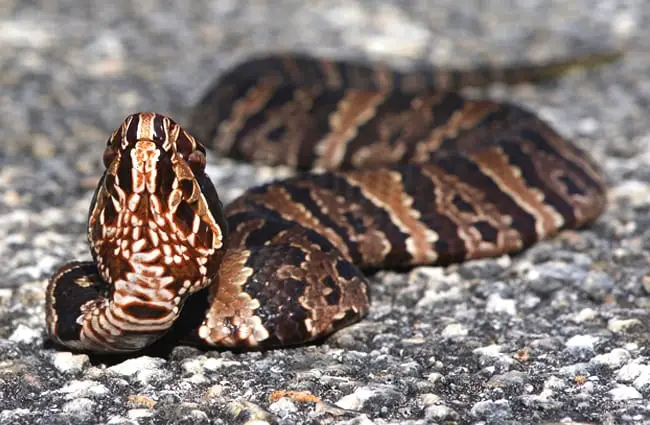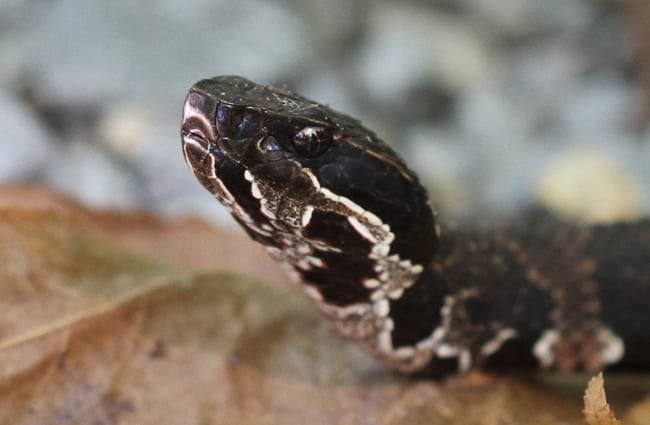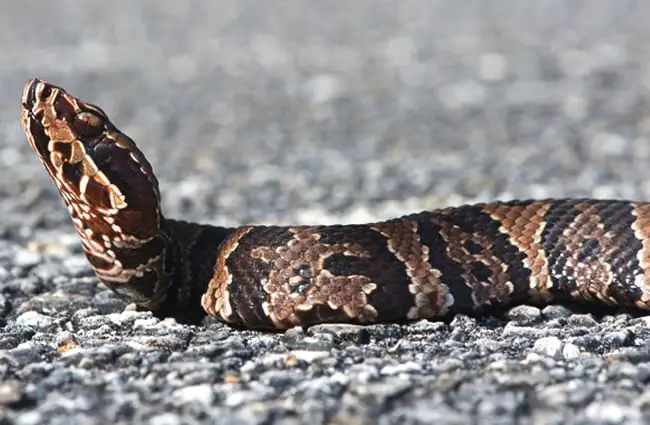The Alluring, and Often Misunderstood, Cottonmouth
The cottonmouth, Agkistrodon piscivorus, is a venomous pit viper native to the southeastern United States. Often shrouded in myth and fear, this fascinating reptile plays a vital role in its ecosystem. This comprehensive guide delves into the world of the cottonmouth, exploring its habitat, behavior, life cycle, and its relationship with both the natural world and human populations.

Basic Information: Identifying the Cottonmouth
The name “cottonmouth” comes from the white, cotton-like lining of the mouth that the snake displays when threatened. These snakes exhibit considerable color variation depending on age and location, ranging from dark brown or olive to nearly black. Juveniles often display vibrant banding patterns that fade with maturity. Adults typically reach lengths of 3 to 4 feet, though some individuals can exceed 5 feet. Their most distinctive feature is the triangular-shaped head, characteristic of pit vipers, and elliptical pupils. They are heavy-bodied snakes and are often mistaken for water moccasins, a common regional name.
Habitat and Distribution
Cottonmouths thrive in diverse aquatic habitats, including swamps, marshes, sloughs, rivers, streams, ponds, and even ditches. They prefer slow-moving or still waters with abundant vegetation and fallen logs, providing both cover and foraging opportunities. Their range extends from southeastern Virginia to Florida, westward to central Texas, and northward into parts of Illinois, Indiana, and Kentucky. They are particularly common in the coastal plains of the Southeast. These snakes require access to both aquatic and terrestrial environments to complete their life cycle.

Finding Cottonmouths in the Wild
For those interested in observing cottonmouths in their natural habitat, patience and caution are essential. Look for them basking on logs or branches near the water’s edge, especially during warmer months. Early mornings and late afternoons are often the most active times. Remember to maintain a safe distance and never attempt to handle or provoke a cottonmouth. They are ambush predators and may strike if they feel threatened. Always be aware of your surroundings, particularly in areas with dense vegetation or murky water.
Diet and Hunting Strategies
Cottonmouths are primarily opportunistic predators, with a diet consisting mainly of fish, amphibians, snakes, rodents, and birds. Juveniles feed more frequently on amphibians and smaller prey, while adults can take down larger animals. They employ a “sit and wait” hunting strategy, relying on camouflage and patience to ambush unsuspecting prey. Using their heat-sensing pits—located between the eye and nostril—they can detect the body heat of warm-blooded animals, even in complete darkness. Once prey is within striking distance, the cottonmouth delivers a venomous bite to subdue and kill it.

Reproduction and Life Cycle
Cottonmouths are typically active from spring through fall, entering a state of brumation (similar to hibernation) during the colder months. Mating occurs in the spring or early summer. Females are ovoviviparous, meaning they retain the eggs internally until they hatch. A litter can range from a few to over a dozen young, born alive in late summer or early fall. Young cottonmouths are capable of venomous bites from birth. They mature relatively slowly, reaching sexual maturity around 3 to 4 years of age. Their lifespan in the wild is estimated to be around 20 years, although some individuals may live longer in captivity.
Ecological Role and Interactions
Cottonmouths play a crucial role in maintaining the balance of their ecosystems. As significant predators, they help control populations of rodents, amphibians, and other small animals. They also serve as prey for larger predators, such as birds of prey and alligators. Their presence indicates a healthy and diverse aquatic ecosystem. Competition for resources can occur with other snake species, such as water snakes, but generally they coexist peacefully. The snakes are susceptible to habitat loss, fragmentation, and human persecution, which can negatively impact their populations.

Human Interactions and Safety
While cottonmouths are venomous, bites are relatively rare. Most bites occur when people attempt to handle or harass the snakes. It is crucial to avoid contact and maintain a safe distance. If bitten, seek immediate medical attention. Do not attempt to capture or kill the snake, as this could delay treatment. Educating the public about cottonmouths and their role in the ecosystem is essential to promoting coexistence. Many encounters result from habitat encroachment by humans, increasing the likelihood of conflict.
What to do if you encounter a Cottonmouth
- Remain Calm: Panicking can lead to rash decisions.
- Maintain Distance: Slowly back away, giving the snake plenty of space.
- Do Not Provoke: Never attempt to handle, capture, or kill the snake.
- Alert Others: If the snake is in a public area, warn others to stay away.
- Seek Medical Attention: If bitten, immediately seek medical attention.
Advanced Topics for Aspiring Herpetologists
The venom of the cottonmouth is a potent hemotoxin, causing tissue damage and disrupting blood clotting. Research into the composition of the venom is ongoing, with potential applications in medicine. Genetic studies are revealing insights into the evolutionary history and population structure of cottonmouths. Behavioral research is shedding light on their hunting strategies, social interactions, and reproductive behavior. Understanding the effects of environmental pollution and climate change on cottonmouth populations is crucial for their long-term conservation.

Caring for Cottonmouths in Captivity
Caring for cottonmouths in captivity requires specialized knowledge and facilities. Enclosures should be spacious, secure, and provide a suitable aquatic environment with both land and water areas. Temperature and humidity levels must be carefully controlled to mimic their natural habitat. A varied diet consisting of appropriately sized fish, amphibians, and rodents is essential. Regular veterinary care and monitoring are crucial for maintaining the snake’s health. Handling should be minimized to reduce stress and the risk of bites. Strict safety protocols must be followed by all personnel involved in their care.
Interesting Facts About Cottonmouths
- Cottonmouths can flatten their bodies and display the white lining of their mouths as a defensive threat display.
- They are excellent swimmers and can remain submerged for extended periods.
- Juveniles have a brighter coloration than adults, serving as camouflage in the vegetated shallows.
- The cottonmouth is a highly adaptable species, capable of thriving in a variety of habitats.
- They play a vital role in controlling populations of pests, such as rodents and insects.
The cottonmouth, despite its sometimes fearsome reputation, is a fascinating and ecologically important reptile. Understanding its biology, behavior, and ecological role is crucial for ensuring its continued survival in a changing world. By promoting coexistence and responsible stewardship, we can appreciate the beauty and importance of this often-misunderstood creature.

![Red Angus Closeup of a beautiful Red Angus cowPhoto by: U.S. Department of Agriculture [pubic domain]https://creativecommons.org/licenses/by/2.0/](https://animals.net/wp-content/uploads/2020/03/Red-Angus-4-238x178.jpg)




![Red Angus Closeup of a beautiful Red Angus cowPhoto by: U.S. Department of Agriculture [pubic domain]https://creativecommons.org/licenses/by/2.0/](https://animals.net/wp-content/uploads/2020/03/Red-Angus-4-100x75.jpg)

